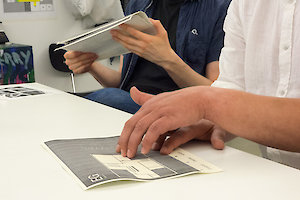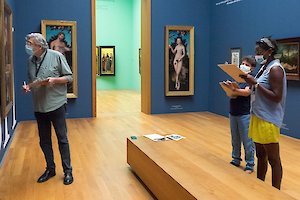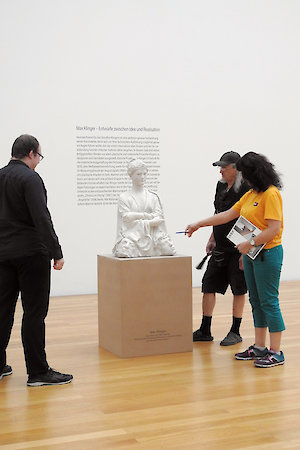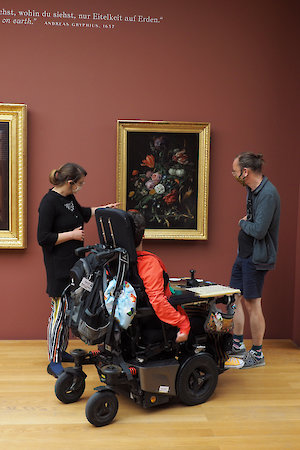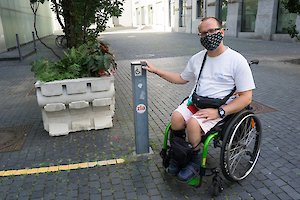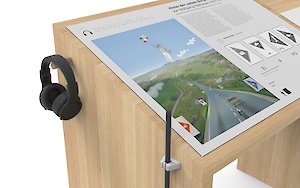MdbK [hubs]
Inclusive educational stations in the museum
In 2022, a total of seven media stations will be installed in the MdbK, offering new access to works in the permanent exhibition and to the architecture of the building. The name MdbK [hubs] - the English term for hub - is emblematic of the concept: different perspectives, mediation focuses and media come together at the stations.
Audio descriptions and tactile reliefs of the artworks, videos with sign language as well as contributions in simple and specialist language offer visitors different ways of accessing works from all epochs. An orientation station in the entrance area provides an overview of the architecture of the building and the different floors and locates functional areas such as the café, cloakroom or toilets. The MdbK [hubs] are aimed at people with and without impairments. In addition to auditory and tactile accessibility, the stations also include in-depth and critical reflections on the artworks in the form of audio and video contributions.
A barrier-free museum
The educational stations are part of an attitude in which inclusion is naturally considered in all areas within the MdbK. The aim is to develop an open and inclusive institution that enables equal cultural participation. The educational stations of the MdbK [hubs] will be supplemented by low-threshold and target group-oriented educational formats as well as barrier-free access in the building.
MdbK [hubs] Advisory Board - Nothing about us without us
To ensure that the interests and needs of the various target groups are taken into account, the MdbK has established an Inclusion Advisory Board. In this body, different focus groups advise on the implementation of the mediation stations and accompany the general development towards a more open, barrier-free institution.
You can find the German PDF-file for the publication here.
You can find the English PDF-file for the publication here.
MdbK [hubs]
in easy language
Mdbk is the abbreviation for Museum der bildenden Künste Leipzig.
The name hubs is English and means node.
At a node, different things and people connect.
At the MdbK, 6 tables are currently being built for various works of art.
The tables are located near the artworks and offer more information:
You can feel tactile images of the artworks on the tables.
On headphones you can listen to a description of the picture.
There is also a tablet with videos in sign language.
There are also short stories about the painting and its time.
There is another table right at the entrance to the museum.
There is an overview of the building to help you find your way around.
There is also a model of the museum on this table that you can touch.
The people at the MdbK have been thinking:
We want a museum where everyone feels comfortable.
We need an open museum.
In order for the museum to open up, we have to think about everyone's needs.
In addition to the tables, the people at the MdbK also want to offer guided tours where people can learn and experience something.
There should be fewer barriers and obstacles in the building.
In order to realise these goals, there is a working group.
The technical term for the working group is the Inclusion Advisory Board.
The inclusion advisory board also includes people with disabilities and impairments.
They accompany the project and help with the creation of the tables.
Partners of the project and Advisory Comittee
tactile studio, Inklisive Designagentur, Alexandra Verdeil und Lena Beck
Dirk Sorge, Bildender Künstler und Kulturvermittler
Diakonie am Thonberg, Stefanie Bergmann und Steven Wallner
Bildungs- & Kunstverein Sagart e. V., Paula Lima, Esperance Mukeshimana-Albrecht, Michael Touma
Stadtverband der Hörgeschädigten Leipzig e.V, Anja Kuhnert
Aufsichtspersonal, Maximilian Lipp und Svetlana Schmidt
Sebastian Schulze, Redakteur und Autor für Audiodeskription
Piotr Selent, Bildender Künstler, Durchblick e. V.
Scouts Gebärdensprache für Alle, Sindy Christoph
Büro für Leichte Sprache, Anja Dworski
Lebenshilfe Sachsen e. V.
Jens Gathemann, Holzdesigner
Katrin Günther, Lektorin
Deutsches Zentrum für barrierefreies Lesen, Sandra Kirsche
Autorin für Audiodeskription und Prüferin, Anke Nicolai und Roswitha Röding
Anna Schimkat, Bildende Künstlerin
Aaron Shoichet, Übersetzer (Englisch)
Projektteam MdbK [hubs]: Katrina Blach, Christopher Utpadel, Carolin Rothmund
Funded by
Saxon State Office for Museums
Landesdirektion Sachsen (Guideline Participation).
This measure is co-financed by tax funds on the basis of the budget passed by the Saxon State Parliament.
